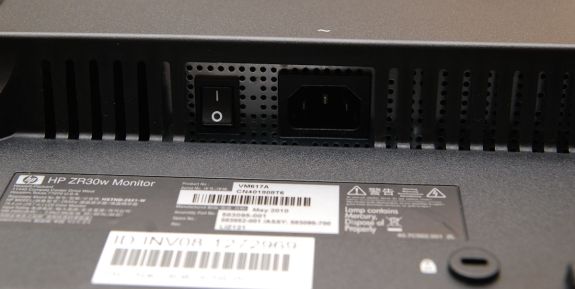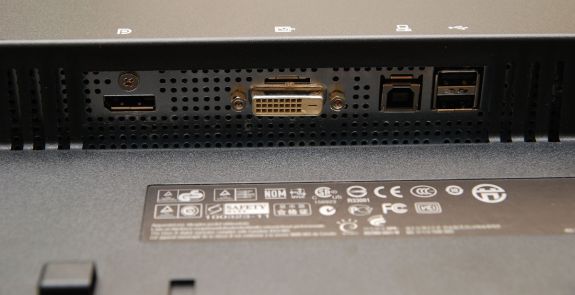A New 30" Contender: HP ZR30w Review
by Brian Klug on June 1, 2010 6:30 PM ESTThe LCD market continues to be one of the frequently updated segments in the consumer electronics segment, as OEMs and vendors alike are eager to bundle their high-end, high performance displays with professional workstations. The ZR30w belongs to that same pro market, offering a 10-bit panel with 1.07 billion colors - for an advertised 99 percent coverage of the AdobeRGB 1998 gamut and 30-bit per pixel color. HP claims that the ZR30w is the first 30" display to break 1 billion colors. When you’re selling a 30” LCD to enthusiasts, every bit of performance matters, and as we’ll show in a bit, the ZR30w doesn’t fail to impress.
As already noted, the ZR30w is targeted primarily at enthusiasts and professionals who demand accurate color tracking and equally large gamut. As with all 30” displays, every detail counts, as this segment represents generally the best of the best for manufacturers. It makes sense, too, since enthusiasts and professionals alike who are serious about getting the absolute largest in display real-estate also care about color tracking and gamut. They expect top performance, and are willing to pay for it. Though similar real-estate can almost be captured with arrays of smaller panels, for most, the 30” segment remains the most lust-worthy among displays thanks to the truly uninterrupted space.
The last 30” HP LCD we touched was the venerable HP LP3065 back in 2007. The LP3065 is still available today as well at $1,349 on HP’s website. The ZR30w is being introduced at a price point of $1,299 - some $300 below Dell’s UltraSharp 3008WFP display. Interestingly enough, the ZR30w does away with the plethora of DVI-D ports we praised the LP3065 for having (almost doubling as a KVM switch). It trims down the 3 DVI-D ports in the LP3065 to 1 DVI-D port and a DisplayPort for the ZR30w. That’s not a deal breaker, but you’re still one input shorter a generation later, which is a bit puzzling. Considering other 30” displays include a plethora of input options, we find the ZR30’s a bit spartan - an HDMI port or component would be welcome additions.
Before we go any further though, let’s dive into the specifications:
| HP ZR30w - Specifications | |||
| Property | Quoted Specification | ||
| Video Inputs | DVI-D, DisplayPort (both with HDCP) | ||
| Panel Type | S-IPS/H2-IPS (CN401808T6 unknown manufacturer) | ||
| Pixel Pitch | 0.250 mm | ||
| Colors | 1.07 billion colors (30 bits) | ||
| Brightness | 370 nits typical | ||
| Contrast Ratio | 1000:1 normal, 3000:1 (dynamic) | ||
| Response Time | 7ms (g2g), 12ms (on to off) | ||
| Viewable Size | 29.7" Diagonal | ||
| Resolution | 2560x1600 (WQXGA) | ||
| Viewing Angle | 178 degrees horizontal and vertical | ||
| Power Consumption (operation) | <130 watts typical, <185 watts maximum | ||
| Power Consumption (standby) | <2 watts sleep | ||
| Screen Treatment | Matte (anti-glare) | ||
| Height-Adjustable | Yes: 4" of travel | ||
| Tilt | Yes: -5 degrees to 35 degrees | ||
| Pivot | No | ||
| Swivel | Yes: -45 degrees to 45 degrees | ||
| VESA Wall Mounting | Yes - 100x100mm | ||
| Dimensions w/ Base (WxHxD) | 27.3" x 19.3" - 23.3" x 10.8" | ||
| Weight w/o Stand | 28.6 lbs | ||
| Additional Features | Integrated 4-port USB hub, HP Quick Release, optional speaker bar | ||
| Limited Warranty | 3 years parts, labor, and onsite service | ||
| Accessories | DVI-D, DisplayPort, USB, and Power Cables | ||
| Price | $1,299.00 | ||
We’ve already talked about the ports, but in case you haven’t used a 30” or equally high resolution panel before, note that dual link DVI is an absolute must. Luckily, HP ships a dual link DVI cable (I’ve seen a few monitors that require dual link DVI actually ship without dual link cables, which always results in a few nightmares) and makes note of it in the instruction manual.
Just don’t expect passive DisplayPort to DVI adapters or other single link DVI interfaces to drive the ZR30w; it won’t work. I experimented with a single link connection just for fun, and the ZR30w refused to show an image. There’s nothing wrong with that, it’s entirely expected. Just be sure you check your cables if things aren’t making sense.

There’s also an internal 4-port USB 2.0 hub. Two ports on the left side of the monitor, two on the bottom near the display inputs. Alongside the standard power connector is a power switch - been a long time since I’ve seen one of those on a monitor.












95 Comments
View All Comments
boe - Wednesday, June 2, 2010 - link
I've been waiting to buy some monitors for years as the 3008WFP had it's share of issues and Apple hasn't released a new LED backlit 30" yet.I'm looking forward to getting a couple of new monitors but not until some higher end models come out with a clear improvement over my 3007wfp's.
xismo - Wednesday, June 2, 2010 - link
I find it a bit dissapointing that you don't list the configuration this was tested on. For example I don't know the gpu the monitor was running on and therefore I wouldn't know whether the gpu had 10-bit support. It would be nice if you could try to add test of 10-bit support as well, how it performs with smooth gradients and so on. As you probably know not too many graphics cards support 10-bit, but all of the workstation class cards do, which I think is appropriate for testing with high end monitors.xismo - Wednesday, June 2, 2010 - link
After reading the comments I see there was a discussion about 10-bit support, sorry for not seeing that earlier. At least I'm not the only one concerned about this :) BTW 5870 does not have 10-bit support as almost all of the other gaming video cards. And using a mini displayport on a macbook pro will not make the geforce 330m have 10-bit support either. Displayport as well as dual link dvi are the only types of connection that are able to process 10-bit color, but you still need a matching video card. Any workstation card like quadro or firepro should be just fine. But yeah including how each monitor displays gradients would be a huge advantage for me, as this is one of the things I'm looking for in a new monitor.Brian Klug - Wednesday, June 2, 2010 - link
Hey there! Thanks for the comment, yeah I'm working on getting us either a workstation GPU or some other way (whole workstation) to really test the 10-bit aspect. It'll happen this week or next and then I'll update. I realized after posting that I forgot to make sure it was working over 10-bit. And you're right about the 5870-it doesn't have 10-bit support. Guess that's one of those arguments for a more expensive workstation version of the card!Cheers!
Brian Klug
awaken688 - Wednesday, June 2, 2010 - link
I'm surprised no one has really complained about the brightness limitation. For professional photographers and graphic artists (the target audience), this would be rough to have no way to see below 150nits as a real means to check for print accuracy. For some of our print shops, 100 nits is accurate to print.Brian,
Did you try adjusting the brightness via the video card as well? I have a monitor that on 0 brightness is still too bright, but I can then go into nVidia's control panel and lower the brightness using that to achieve the correct brightness or lower the RGB manually (which I understand isn't an option for this monitor). Just wondering. Nonetheless, this should at least be able to hit 120 nits for imaging professionals. Good article though. I like the monitor reviews for sure.
Soldier1969 - Wednesday, June 2, 2010 - link
Thanks for the review, not a bad price for a new 30 incher compared to other brands. Those people here that want 24" reviews those are a dime a dozen and for the poor. I had a 24" 1920 x 1200 monitor long before most did since 2007 when they cost a fortune. So glad I jumped to 2560 x 1600, gaming on them owns everything else out there! Blu ray looks fantastic! If youve never experienced computing on a 30 incher your missing out!kasakka - Thursday, June 3, 2010 - link
The lack of OSD is what kills this for me. I find that without it getting accurate colors is more difficult and if you want to also use the display for gaming, some games may totally ignore calibrated color profiles or software adjustments. The lack of a scaler is a bit annoying too, but since graphics cards can do that at least in Windows, it's not really a problem.Regarding inputs, I currently have a Dell 3008WFP and its gazillion inputs is a huge minus for me. I only need one DVI and one Displayport, so having to cycle thru all the useless inputs is annoying. More annoying is the 3008WFP's (and the 27" Dell U2711's) circa 5 second delay when swithing resolutions or inputs. But I guess I'll stick with the Dell until someone comes out with something better.
pmeinl - Thursday, June 3, 2010 - link
Does the AG coating of the ZR30 have this annoying sparkle effect like other current IPS panels (ex: U2410).Working on my two U2410 (programming, text processing) causes me eye strain.
pmeinl - Friday, June 4, 2010 - link
As some people do not see the sparkle problem, here is a thread with a picture of it:http://hardforum.com/showthread.php?t=1466914&...
B3an - Thursday, June 3, 2010 - link
So just to be clear... does this display do more colors than the Dell 3008?